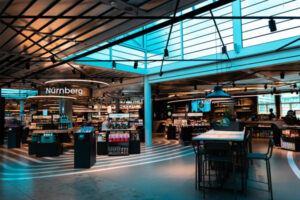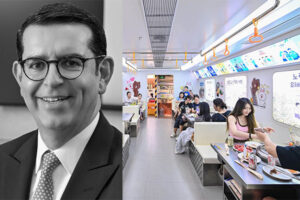By Piotr Wasilewski
Retail parks have experienced somewhat of a revival in recent years. They were a popular format in the 1990s and were built primarily on the outskirts of large cities. Their concept has changed: Even though they are still present in the largest agglomerations, at present, they are predominantly found in cities that have populations between 50,000 and 200,000 inhabitants and offer consumers access to modern commercial offers. Such formats are attractive because of their convenience and good accessibility. Thanks to their expansion, popular international brands have begun to appear in markets where they had previously not been present. Generally, the commercial offer of a retail park consists of a supermarket (e.g., Carrefour, Lidl, Biedronka, Aldi, or Kaufland), a value retailer (Pepco, KiK, Dealz, or Action or Tedi, which have recently entered the Polish market), a drugstore (Rossmann, HeBe), a shoe store (Deichmann, CCC), an electronics/household goods store (Media Expert, NeoNet, RTV Euro AGD), and other specialty stores (e.g., pet shops, bookstores, etc.). The GLA of a retail park is usually 5,000 to 10,000 sq m, the facility is located in a single-story building with an external parking lot, and, in many cases, each store has a separate entrance from the outside.
Power centers represent the further development of the concept. Such facilities are on a larger scale and are usually located on the outskirts of larger regional cities. Their GLA exceeds 10,000 sq m, and they provide a more extensive commercial offer (home & garden, grocery store, and the occasional a large furniture store or a cinema). Such a project was recently launched in Siedlce. Stop Shop, Selgros, and Castorama are combined in the retail park. Additional similar projects are planned, such as the investments of Shopp City in Gorzów Wielkopolski, Słupsk, and Włocławek.
Convenience centers are being built in cities with fewer than 50,000 inhabitants, and they are usually the largest commercial facilities in those areas. Their GLA is between 2,000 sq m and 5,000 sq m. They allow customers to shop quickly and are usually located on the main roads or in the most populated areas of the city. The structure of their offer is similar to retail park, but due to the limited GLA, the retail spaces are smaller and the number of stores is more limited.
Retail Parks – the New Mainstream
In recent years, the popularity of retail parks, which formerly operated in the shadow of shopping malls, has grown. In the first half of 2020, eight new retail parks were built in Poland, while another three were expanded. Currently, the total GLA of projects under construction amounts to 450,000 sq m, while the share of retail parks exceeds a quarter of that figure (26%). Over the last 10 years (2010 to 2020), their share in the total supply has increased from 9% to 13%. What is the reason behind their success?
The key advantage of modern retail parks is their local character. In cities with more than 50,000 inhabitants, there is a need for a modern commercial offer. Their residents want to be able to make quick purchases within their own cities, and they do not want to be forced to travel to larger agglomerations every time they need to do their shopping. In addition, retail parks have impact on their surrounding counties as they are interesting alternatives to big commercial facilities in the largest provincial cities. The goal is simple: Retail parks have to meet the vast majority of purchasing needs. Developers and tenants consider such formats as opportunities for their businesses. Over the years, they have noticed that the purchasing power of the inhabitants of smaller cities has increased significantly. Brands that used to only be found in the largest agglomerations have realized that they can expand and increase revenues. The key to success is a tenant mix that meets the needs of the local community and makes the facility versatile.
It is important to note that both the construction of and the leasing costs at local retail parks are significantly lower than those at larger shopping centers in larger cities. That creates new opportunities and makes the launch of new retail parks, even in small towns with populations of around 50,000 inhabitants, a sensible option. Due to the growing needs of consumers and the relatively low level of investment (compared to shopping centers in large cities), the business risk associated with such projects is relatively low. With regard to convenience centers in cities with fewer than 50,000 inhabitants, the situation is similar. That explains why, despite the difficulties associated with the pandemic, the biggest players in the retail park and convenience center markets, such as Immofinanz, Karuzela, Trei, and Saller, are planning to enrich their portfolios with new facilities.
Most Resistant to the Effects of Covid-19?
Nearly every retail park in Poland resumed operations at the end of May. In the vast majority of cases, tenants managed to reach agreements with the property owners regarding conditions, thereby enabling them to overcome the crisis caused by the pandemic. Why? It turned out that those formats were well prepared to return to the market, and their characteristics suited the new expectations of customers, with respect to the pandemic.
The increase of footfall at large shopping centers and malls is a simple matter of time. Shopping needs are not the only issue: People have a strong desire to socialize, and they need to spend time with others. In recent years, the concepts of modern shopping centers have been built around those needs. Food courts and leisure zones even accounted for up to 20% to 30% of the total GLA. However, if we want to return to the situation as it stood prior to the Covid-19 crisis, the world must deal with the effects of the pandemic as well as the resulting threats. Up to now, we have existed in the realm of social distancing, and consumers are eager to reduce the time that they spend in stores to a minimum. Their goal is to shop efficiently and to avoid inadvertent interactions with other people as much as possible. Such behavior is perfectly in line with the design assumptions of retail parks and convenience centers. The availability of common areas is minimal (sometimes, there are no common areas at all), outdoor parking is plentiful, the stores can be entered from the outside, and there are no stairs or escalators – all aspects that contribute to making customers feel safer. The effect is further enhanced by the local character of regional retail parks: Customers often know the sales staff and do not feel anonymous when visiting the stores.
Given those arguments, it is hardly surprising that when the lockdown was lifted, customers primarily flocked to retail parks. The outlook is optimistic. According to July’s Retail Institute forecasts, smaller-scale facilities (5,000 sq m to 20,000 sq m), including retail parks and outlet centers, should return to pre-pandemic footfall by this fall.
Taking Advantage of a Positive Trend
Both developers and tenants see the growing potential of retail parks and convenience centers. The success of such formats confirms the growing maturity of the retail market in Poland, which is becoming increasingly decentralized. The construction of new, local facilities makes the modern commercial offer more available for consumers living in small towns. The development of the retail park format is a promising prospect for investors who plan new projects within the commercial real estate market. It also creates new opportunities for tenants due to the potential expansion into new local markets. The figures speak for themselves – 40% of new retail space delivered in Poland in 2020 is comprised of retail parks. A low average vacancy rate at such facilities (approximately 3%) encourages new investments. The future of retail parks in Poland looks promising.






